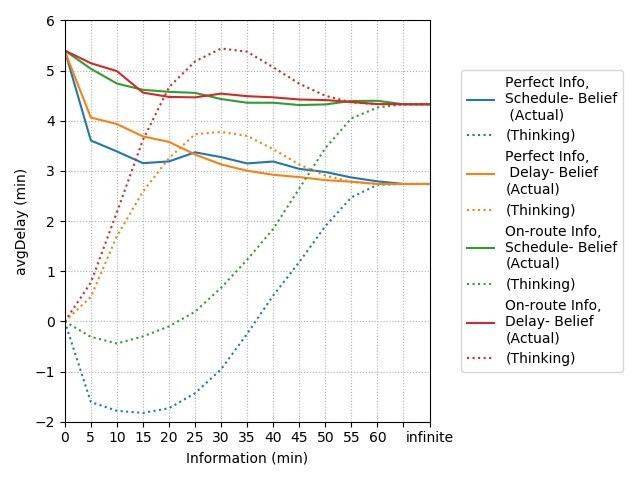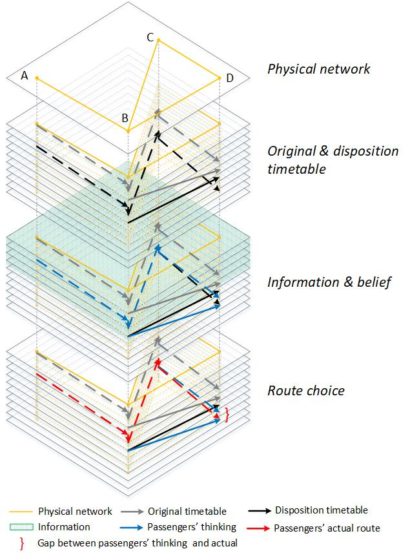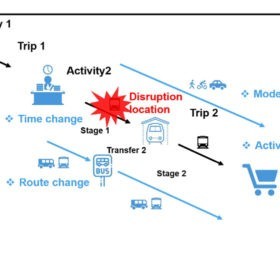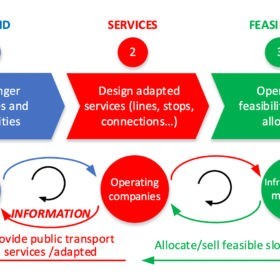
In case of railway delays, train operating companies update the planned timetable to the actual disturbed conditions to keep offering high quality services to travellers. Passengers face an adjusted service, and corrective actions (a disposition timetable). This communication is often assumed to be perfect, complete and immediate, which is hardly the case. There is only one correct information; in contrast, there are many possible ways, in which information is partially wrong.
For instance, the disseminated information could be incomplete or inaccurate in reality, that is, not all the passengers can immediately receive all the information about the disposition timetable. One crucial role of communication is to describe future operation, which are by definition unknown, and make sure that passengers make the best decision, based on the communicated information, despite the presence of delays and timetable adjustments.

We study how to understand the effects of incomplete information to passengers towards their route choice and behaviour in a railway network. We propose a novel multi-layer time-space-event-graph model to describe heterogeneous passengers’ thinking about disposition timetable under different types of incomplete information. This multi-layer time-space-event-graph consists of five layers:
- original timetable,
- disposition timetable,
- information,
- passengers’ thinking layer,
- and passengers’ actual route choice in reality.
The first two layers are the same for each passenger, in fact describing a time-extended p-space representation of the network in its planned, and actual characteristics. The last three layers depend on each passenger’s departure time, and the time of each train at each station. In this paper, we specifically apply this model to railways, but it is applicable to any public transport network as far as the public transport services can be described as time-space schedules.
Functionality
We distinguish between information about current or past conditions, and belief about possible future conditions. We are able to apply the proposed multi-layer time-space-event-graph model to describe passengers’ behaviours incorporating the impacts of incomplete information («Perfect Information» or «On-route Information») and their belief («Schedule-stubborn Belief» or «Delay-extended Belief»). The information time horizon is also considered, from zero (i.e. no information) to infinite. Due to different incomplete information and passengers’ belief, there might be a gap between passengers’ thinking and the reality. This gap can result in an optimality issue; i.e. there is a variation between what is expected, and what is experienced; or even a feasibility issue, i.e. the route does not exist. Therefore, incomplete information might affect feasibility of passengers’ routes, and passengers’ delays.
Results
The evaluation of passengers’ behaviours in railway network under different incomplete information and beliefs is reported by a realistic case study. The results show that the «Perfect Information» helps passengers to have a larger set of considered paths, by about 50% more feasible routes, moreover decreasing passengers’ delays, compared to «On-route Information». The effects of passengers’ belief with on-route information are negligible; but are large in case of perfect information, depending on information time horizon. When information is available only for a short time ahead, «Schedule-stubborn Belief» cause fewer passengers’ delays in reality. The results most probably relate to the rescheduling strategies from operating companies, which often result in keeping the train orders/ sequences in train delays. In that case, the rank between possible route choices is maintained through the disposition timetable. Nevertheless, with «Schedule-stubborn Belief», passengers might not be satisfied, as they expect to face no delay, or even to arrive earlier, while they will experience some delay, in reality. In contrast, passengers can be pessimistic about the delays (i.e. actual delays less than thinking delays) with «Delay-extended Belief». When available information is enough, both those gaps decrease; this effect most probably relates to possible transfers in the network.
Nuannuan Leng is a scientific assistant at the chair of Prof. Dr. Francesco Corman at the Institute for Transport Planning and Systems (IVT) at ETH Zurich. The title of her PhD thesis is «The role of information to passengers in public transport disruptions». Her current research focuses on the effects of uncertain information to passengers in public transport delays.
Award: The Role of Incomplete Information to Passengers in Railway Delays was one of winning papers of the 2020 INFORMS – Railway Application Section (RAS) Student Paper Contest.

